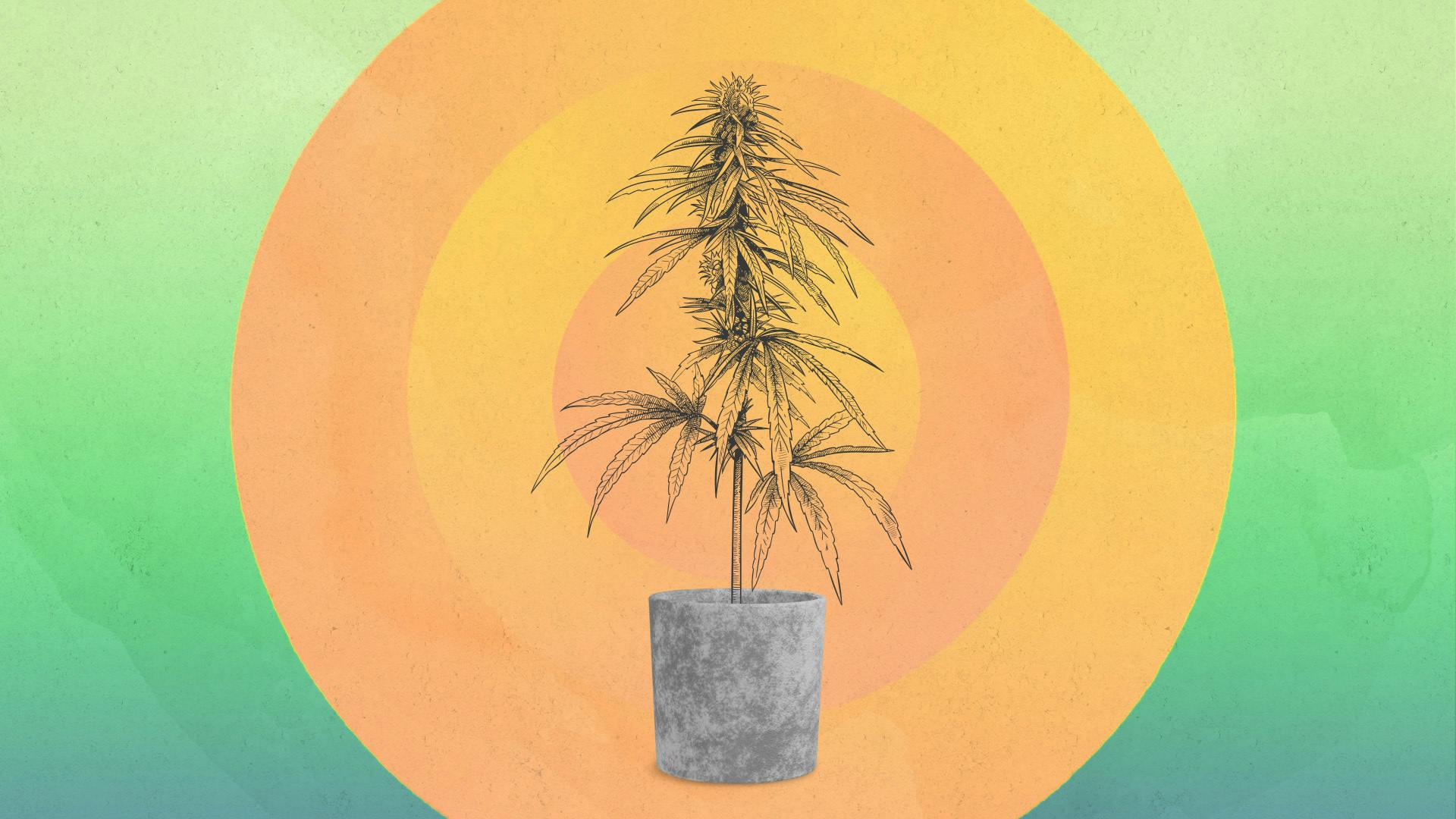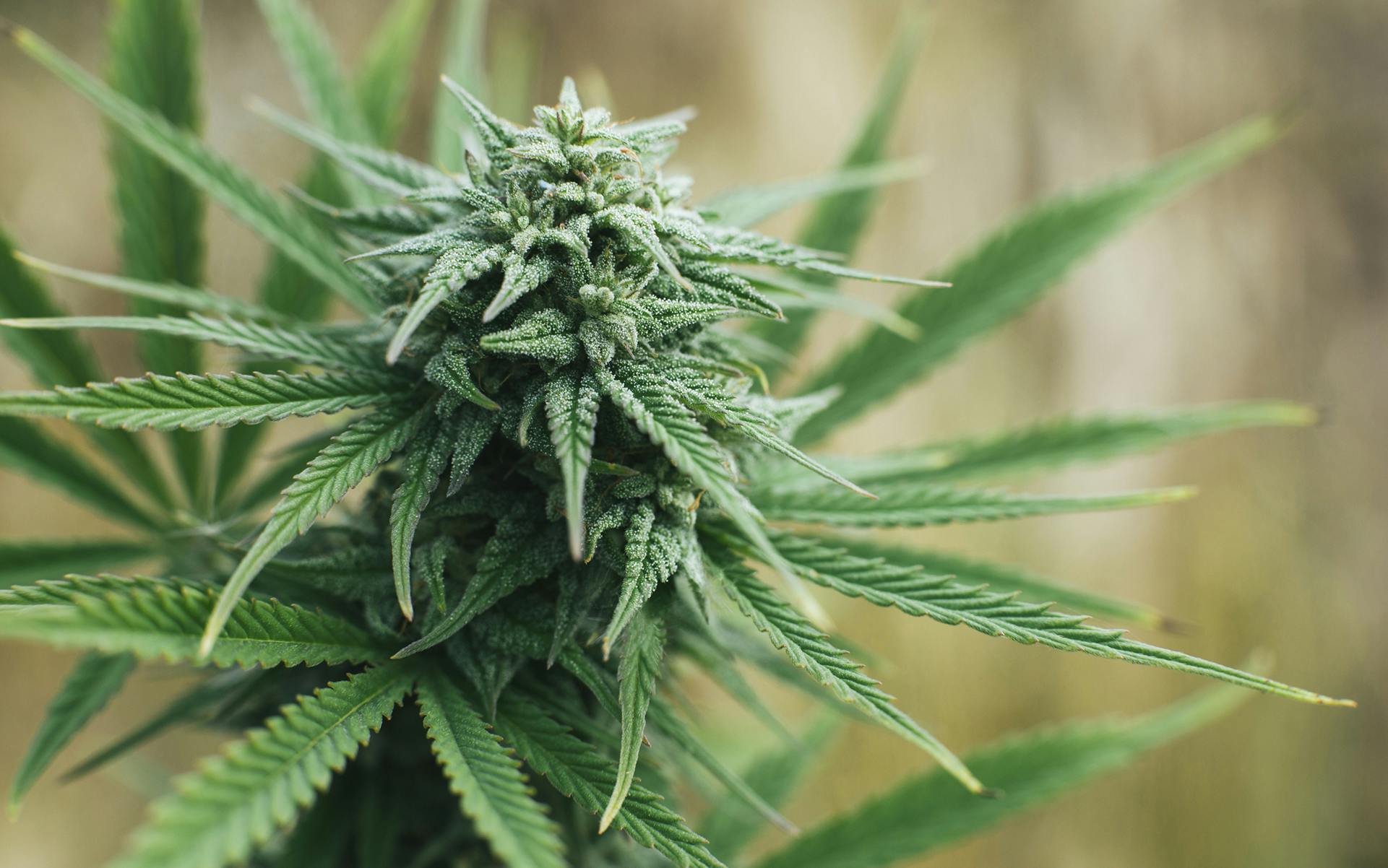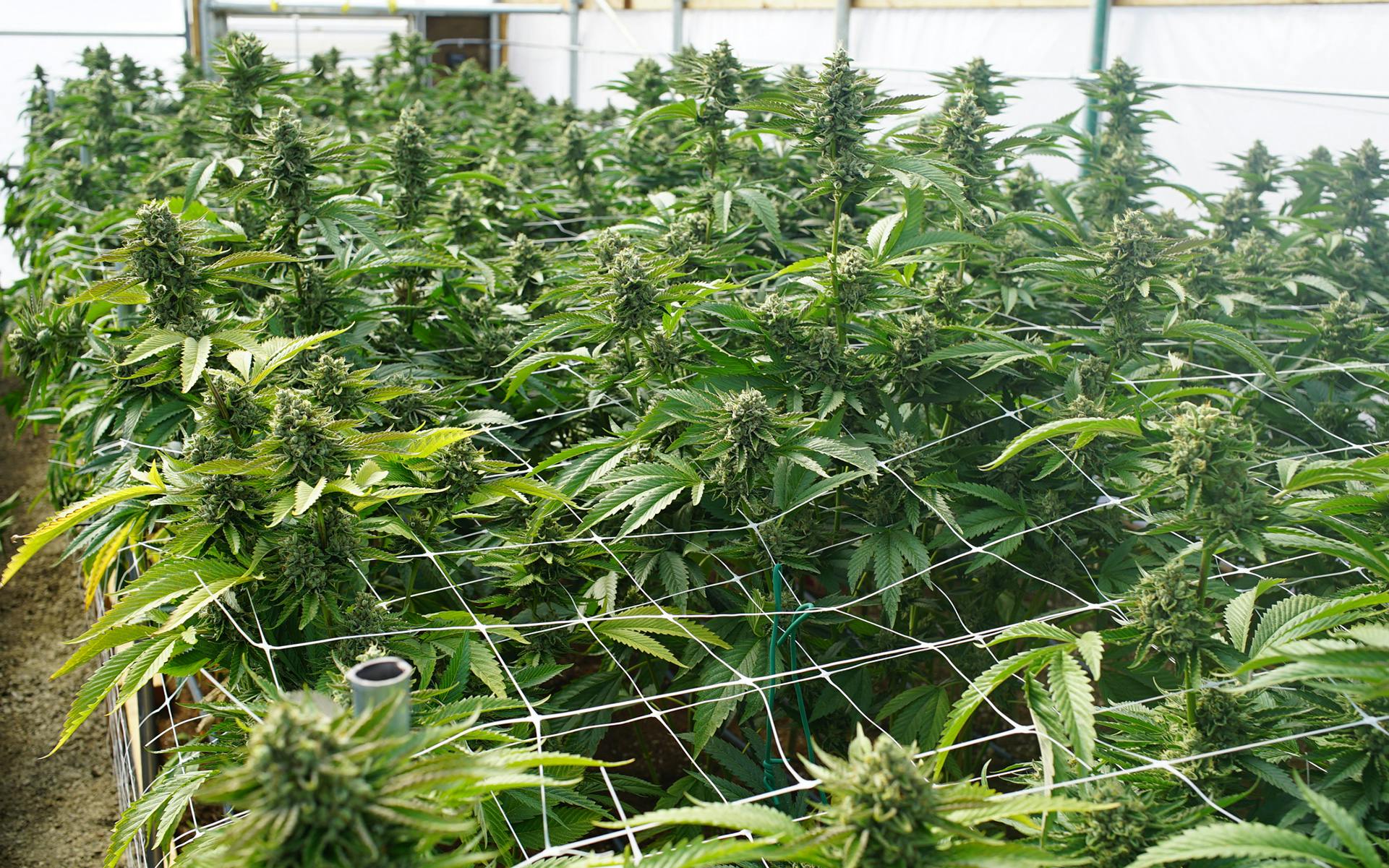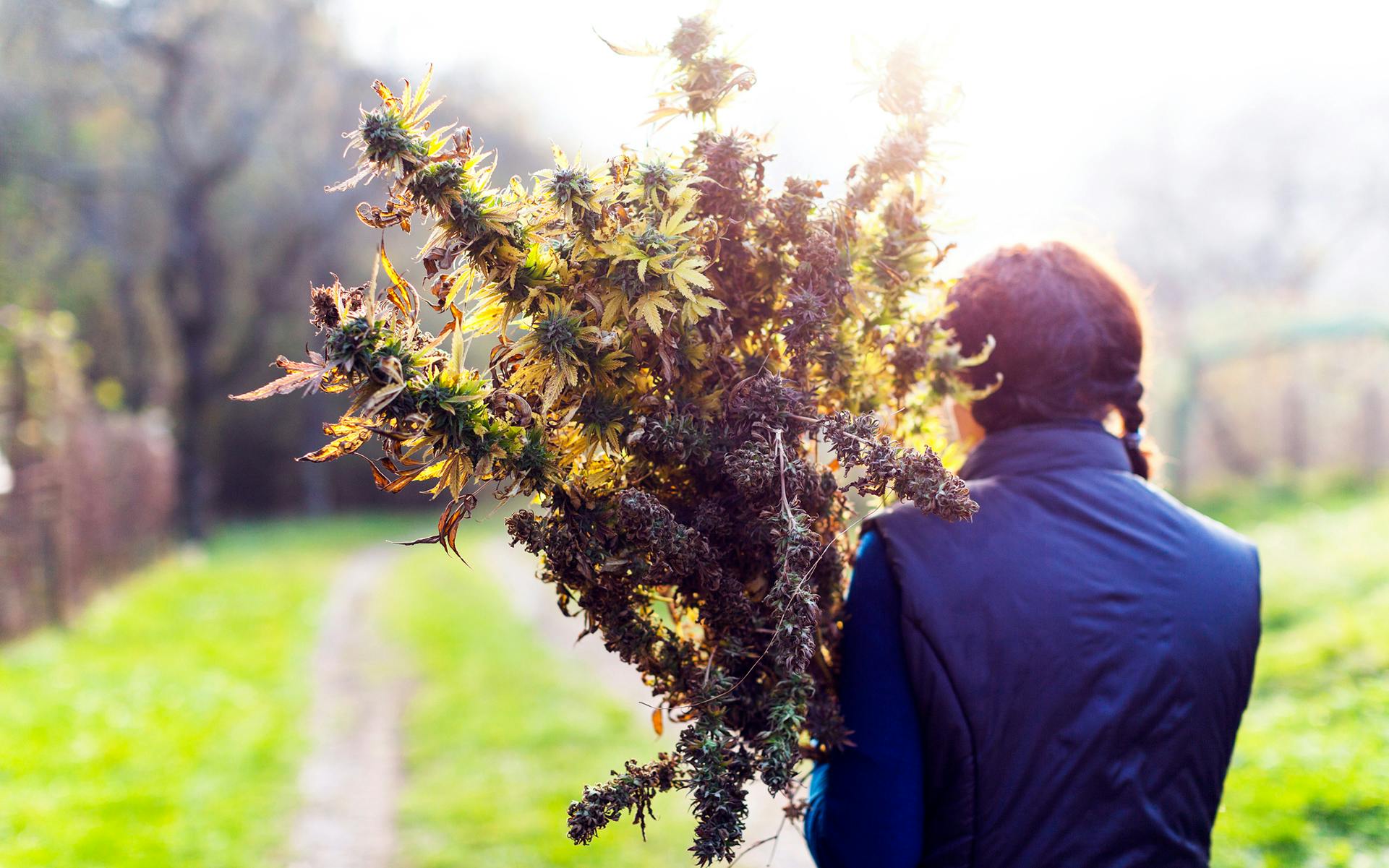
As states legalize weed and the plant becomes more accepted, more people are trying out their green thumbs by growing their own weed at home. Most states with legal weed allow one person to grow six plants at their residence and an entire household to grow 12 plants. Some allow less, and some allow more.
(To see how many plants your state allows you to grow at home, check out this table).
But how much actual weed is that in dried buds that you can smoke? An ounce? A pound? Two pounds? The tricky thing is, all weed plants aren’t the same size, and many factors affect how big a plant will get and how dense its buds become.
We’ll go through those factors and talk a little bit about the harvest process to estimate how much weed you can get from one plant.
How much bud from one weed plant?

Many factors affect how big a plant gets, but generally speaking, if you are growing a healthy plant, you can expect these yields from one weed plant:
- Outdoor plant: ½ pound of buds, or about 224g
- Indoor plant: ¼ pound of buds, or about 112g
Note that these are estimates. When growing outdoors, plants can usually get massive because they aren’t restricted to space—it’s not uncommon to get closer to a pound a plant or more.
When growing indoors, you’re often limited by space—a plant can’t get as big in a grow tent as in a big, open basement. You’re also limited by how powerful your grow light is. For example, Leafly editor David Downs harvested 150g from one indoor plant with one 200W Black Dog LED light. The company said that light maxes out around a half-pound of buds, or 224g.
Also, these estimates are for healthy plants. If a plant becomes nutrient-deficient, gets bugs or mold, or doesn’t receive enough light, expect a lot less.
How long will one plant’s worth of bud last you?
However big your plant gets, you’ll likely have more flower than you know what to do with. Many people will save a certain amount of flower for smoking, and make edibles, concentrates, and other weed products with the rest of their harvest.
Shop highly rated dispensaries near you
Showing you dispensaries nearConsider how much weed you smoke in a day, week, or month. For reference, a gram is about two medium joints or 3-4 bowls. Do you smoke a gram a day or a week? Two grams a day or a week?
Grab some seeds for your grow

“ILGM features a wide range of seeds from stellar American growers in addition to their ever-reliable in-house brand.”
– Leafly “Best for Beginners” seed bank pick
We may earn a small commission if you buy through links on this page.
Using the above yield estimate of ¼ lb., or 112 grams, for one medium-to-large-sized indoor plant, if you smoke one gram a day, that one plant would last you 112 days, or just under four months! Two grams a day would last you just under two months, and half a gram a day—or an eighth a week—would last you eight months.
This will help give you a sense of how many plants you should grow. If you’re growing indoors, you can grow one plant at a time, harvest it, and start another, keeping a continuous cycle of growing.
If growing outdoors, you may only get one harvest a year. Remember, check out how many plants you can legally grow in your state here.
Factors that determine a weed plant’s yield
The amount of dried buds you harvest from a weed plant is called its yield, just like any crop, such as corn, wheat, fruit, etc. Ideally, when growing weed, you want high yields and high-quality buds. Getting both takes a little practice.
A weed plant will lose about 75% of its weight to moisture loss and trimming after being cut down. A considerable amount of moisture leaves the plant during the drying process, and trimming removes all the stems, branches, fan leaves, and trim from the plant.
So if you weigh a freshly cut plant at three pounds, don’t get too excited—you’ll likely get ¾ lb. of finished buds (which is still a lot of weed).
A big plant doesn’t necessarily mean big yields, as buds can be thin and wispy. A medium-sized plant with quality, dense nugs could yield more than a six-foot tree. Also, if growing multiple plants, they can grow over each other and shade one other out, reducing yields. Make sure to give plants plenty of space.
Some major factors that contribute to a weed plant’s yield include:
- Strain/genetics
- Grow duration
- Light
- Climate
- Soil type/amount
Strain/genetics
Certain weed strains grow big or tall or are high-yielders simply because of their genetics. Traditionally, indicas grow short and stout, and sativas grow tall and lanky. That’s not always true across the board, but it is a good rule of thumb.
For example, Lemon Skunk is famously a tall, lanky strain, so you’re likely to get high yields from it. Blue Dream and Chemdog are also known for their high yields.
Aside from its candy-like flavor, Runtz gets its name because its buds grow small, like the runt of the litter. It might be a low-yielder, but you’ll usually get high-quality buds.
Growth duration
How long you allow a plant to grow, or the length of time from seed germination to harvest, is one of the most significant factors determining weed yield. If you start growing seeds in March rather than May, those plants will have two extra months to get big.
When growing outdoors, the local climate is the main determining factor of when you can put seeds in the ground. Some regions are too cold to put plants outside until May, but you can start growing plants indoors with the right setup.
Some regions get rain early in the fall, so you’ll want to grow plants that are ready to harvest by the beginning of October. In tropical climates, you can practically grow weed outdoors all year round.
When growing indoors, growth duration is determined by how much space you have to work with. If you have a spacious basement or shed, you can let plants grow for months and get as big as you want before forcing them to flower. If space is tight, like in a grow tent or other small areas, you may only be able to let your plants get a few feet tall.
Light
How much light a plant receives is highly variable. When growing outside, it all depends on where a plant is located to receive the most light throughout the entire season. Weed plants like full sun—at least six hours of direct sunlight every day. If a plant is in the shade or gets shaded as the light changes throughout the season, it can affect yields.
Indoors, it depends on how powerful your light is. A small 200W LED is great for a small grow tent, but you’ll need something bigger for a bigger space, which also means a more expensive light.
Be sure to prune your plants to remove dead leaves and buds, and branches that won’t turn into sizable buds. Clearing out plant matter will allow the quality buds to get more light.
Climate
Weed typically likes warm, temperate climates—think of Northern California’s Emerald Triangle region—but certain strains thrive in different temperatures. Traditionally, indicas like cold, dry climates and sativas like warm, humid climates.
Sudden extreme changes in temperature can affect a plant’s growth and yields, such as a sudden cold snap, which can slow a plant’s growth, or a heatwave, which can dry out a plant.
Soil type/amount
Different soils have different nutrient levels and some nutrients can promote plant growth. You can also add nutrients to soil or water to help plants grow big and strong.
Additionally, if growing in containers, the size of the container, or the amount of soil the plant’s roots have, will affect the size of a plant. Growing in too small of a pot can stunt a plant’s growth.
Check out guidelines on how big of a container you need for different sized plants here.
Growing directly in the ground will give your plant’s roots plenty of space, but you may need to add nutrients depending on the soil’s quality.
Read more of Leafly’s guide to growing marijuana
- How to grow weed: Basics of growing marijuana
- 4 stages of marijuana plant growth
- Marijuana plant anatomy
- How to grow weed indoors
- How to grow marijuana outdoors
- Cannabis seeds 101: How to grow marijuana from seed
- How to clone cannabis plants
- Marijuana seedling and plant care
- How to harvest marijuana plants
- Troubleshooting common cannabis plant problems
- Buyer’s guides for cannabis seeds and growing equipment
- How to grow marijuana using hydroponics, aeroponics, or aquaponics
Ready to start growing your own marijuana?
By providing us with your email address, you agree to Leafly's Terms of Service and Privacy Policy.



